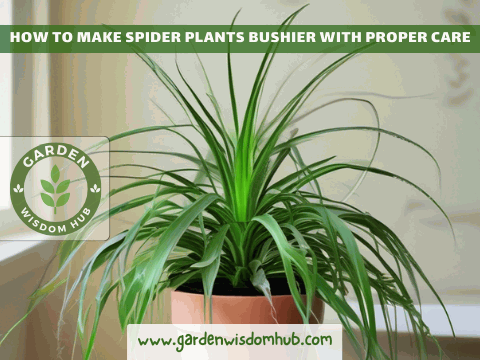How to Propagate Spider Plant for Healthy Growth
Chlorophytum Comosum, commonly known as the spider plant, is one of the most popular houseplants due to its eye-catching appearance, long green leaves with yellow stripes, and extremely convenient growing mechanism. There are varieties available for this plant, mainly named Vittatum and Variegatum.
As easily as it grows, certain precautions need to be taken while growing the houseplant. It requires a neutral soil pH and moderate temperature to survive. Harsh weather can cause the ends of the leaves to turn brown, indicating an unhealthy environment for the plant.
White flowers can bloom during the summer season on spider plants’ stems as well as on immature spider plants or the ‘pups.’ The plant is in high demand due to its natural air-purifying abilities.
How To Propagate your Spider Plant
Although the roots of the baby spider plant will be weaker at the development stage, it is necessary to allow the growth of roots by putting the ‘pup’ in water before it is finally shifted to the soil.
For that purpose, it is crucial to handle the cutting of the plantlet with a sterilized pruning tool. After that, the remaining leaves from the base of the plantlet will be removed carefully and kept inside a watered pot in the presence of indirect sunlight. Once the roots are approximately 2 to 3 inches long, the baby spider plant will be ready to be shifted to the soil.
There is a slight possibility for them to be unable to handle the shift sometimes, but it is always a good idea to let the roots grow in a deeper pot to prevent the plant from falling outside the pot.
Propagating The Spider Plant Using Damp Towel
With not much difference from the traditional way to grow a spider plant, another possibility is to keep the cut part of the plant in a deep dish with a damp towel.
The only condition is that the towel must not run out of moisture at any cost; otherwise, the plantlet will die. Once the roots have grown up to 1 inch, it will be suitable for them to be shifted into a pot with soil.
How do I propagate spider plants Without Plantlets
There are ways to propagate your spider plant with plantlets, but there is a way one could grow more plants from healthy and undamaged mature plants with proper roots. One plant will be divided into as many smaller plants as naturally possible with its own set of leaves and roots. It will then be put in a potting mix to stimulate the growth of more plants.
Spider Plant propagation from leaf:
Like human mothers, spider plants have the ability to provide vital nutrients for their immature baby plants till they can absorb them on their own. When the plantlet is untouched and not removed from its parent plant, a long stem-like structure called ‘stolon’ becomes a carrier of the nutrients from the parent to the baby.
However, one must be aware that leaves do not produce plants since the presence of roots is the major element in the process of propagation.
- Explore our article on the Different Types & varieties of Spider Plants to learn more about their types & varieties
Precautions While Taking Care Of The Propagated Plant
Like many other plants, it is not a healthy approach to overwater the plant either when it is immature or when it has grown into a complete plant. Normally, spider plants require moisture rather than liters of water to survive.
Simultaneously, it is never advised to over-fertilize the plant once it has reached the point of being able to be fertilized every three months.
Lack of proper attention towards the houseplant might result in brown tips (which represent wilting of the plant), pests (infestations could ruin the entire plant, resulting in decay), and root rot (which occurs due to the blockage of draining systems, leaving excess water for the roots to rot)
- Watch this YouTube Video For More Guide How To Propagate Spider Plants
How to make spider plants bushier with proper care

Pruning the plant, either moderate or excess, never goes to waste. The plant definitely grows better when it is pruned regularly, just as it is watered regularly in bright light.
Best time to bushier your spider plant:
Sometimes, effective propagating and pruning could make the plant grow so much faster that it will need a new pot. If the growth appears stagnant, one must ensure a new pot so that the bush becomes bigger and better, taking as much space as it requires!
It is not always necessary to prune the siderites off the parent plant, but if it affects the growth of the parent plant, pruning works like magic in the regrowth of the plant!
When to propagate spider plant
While spider plants are considered to be the favorite plants of gardening enthusiasts due to their ability to grow throughout the year, the best time to propagate your spider plant Bushier is the summer and spring seasons because they provide enough bright light to plant to survive brown tips.
Once propagation in water has started, approximately ten days will be taken by roots to form, after which transplant can take place. However, if the siderites are directly sown in the soil, it might take a bit longer for the roots to appear.
Narrowing It Down
As discussed, spider plants are low-maintenance plants that need almost basic care and gardening tools to take care of. Other houseplants like jade plants, Venus flytraps, and rubber plants might need a lot of care and supervision.
Spider plants, on the other hand, are dependent on relatively fewer factors to survive, thus making them a good option for trainee gardeners.
Of course! There will be uncertainties and some days, the plant will require intensive care and effort, but it will all be worth it, considering that the plant is a natural air purifier. No extravagant electric purifiers will then be needed. Neither expensive fertilizers nor pH-balancing chemicals are needed.
Apart from the finances being saved, the propagation of this plant is considered to be a contribution to growing greenery around the world. People grow this plant in masses, for gift purposes, for selling purposes, and for decorative reasons. In neither way do spider plants pose a threat to our environment because they simply grow and produce smaller plants out of them.
- Explore our article on the Growth Stages Life Cycle & Care Guide to learn more about their growth journey.
Types of Spider Houseplants:
Importance of spider plant propagation
The fact that it produces siderites on its own, a spider plant, if looked after properly, is a one-time investment. Once bought, a spider plant will automatically provide multiple baby plants to grow the greenery around.
For someone who has pet animals, the spider plant remains a safe yet playable plant for dogs and cats who are prone to get into trouble by trying out new things!
Similarly, the plant is no hazard for babies who have just begun crawling. Avoids the occurrence of pollen allergy and the risk of thorns. It simply does nothing but make one’s house look fancier and elegant.
For someone struggling with their mental health, a spider plant could be a great source of distraction from sadness-inducing thoughts. Taking care of a plant could be less stressful than looking after a toddler or a pet.
When we talk about mental health, it is equally important to mention how plants and gardening can improve focus. How much has the plant grown? Is that enough water? Does it need light? Is the temperature fine? Frequent questioning and awareness of surroundings improve focus and, hence, sleep. Sound sleep will be a result of an organized thought process.
Anyone interested in gardening will reach out to someone with similar interests, and healthy friendships can be formed. It might be possible for someone to catch an allergy to spider plants somehow, which restrains them from having such interests.
Pros and cons of propagating spider plant:
But if we evaluate the ratio of pros and cons of propagating and growing bushy spider plants, we see that there are good aspects to it. From the many dimensions, gardening holds a certain level of peace for the ones who truly value the art of growing plants.
It takes time and requires patience, and that is the beauty of a plantation. Where it purifies the air by itself, it teaches patience and kindness, how one living creature learns to provide the best for another living being in the same environment.
To learn more about Houseplants check out my guides:
Tips to Save a Dying Corn Plant: A Step-by-Step Complete Guide
How to Revive and Save an Aloe Plant: A Complete Guide
How to Care for Majesty Palm: Essential Tips for Healthy Growth
Aloe Plant Overwatered: Signs and Step-by-Step Solutions
6+ Signs of an Underwatered Aloe Vera Plant (And to Revive It)
Ultimate Guide To Growing Herbs Indoors With Grow Light In Pots
A Complete Guide On Starting Your Very Own Indoor Herb Garden
The Ultimate Guide to Bird of Paradise Care and Growing
Overwatered Spider Plant – Signs and Step-by-Step Solution
James Porter
Welcome to our haven of gardening and plant care, where outdoor and indoor planting enthusiasts come together! At Gardening Wisdom Hub, we aim to provide you with the most authentic information on anything related to gardening, plant care, seasonal planting etc.
The author of our website is James Porter, an experienced industry veteran. He has a deep interest in everything green. James’s enthusiasm for exploring plants’ features and learning new gardening methods began at a young age. Gradually, his passion increased with time, leading him to become a highly esteemed professional. His extensive knowledge makes him a priceless resource for inexperienced and seasoned gardeners.
